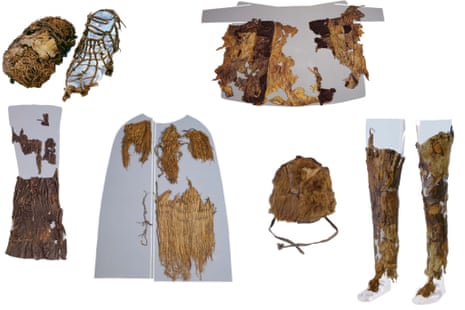Ötzi the Iceman, a naturally mummified corpse found trapped in the ice of the Italian Alps, has become something of a celebrity in the 25 years since tourists first stumbled upon his frozen remains – so it’s no surprise that his sense of style has come under scrutiny.
Scientists studying the 5,300 year-old remains say they have finally unravelled the secrets of Ötzi’s wardrobe.
The new research reveals that the iceman was potentially a versatile tailor, with skins from sheep, goats and cattle as well as hides from a brown bear and roe deer used to create his outfit.
Ron Pinhasi, co-author of the research from University College, Dublin said the findings show that Ötzi was “pretty picky” when it came to his choice of skins. “To me it seems pretty sophisticated in terms of the capacities to use so many different materials from different animals,” he said.
Aged around 45 years, Ötzi is believed to have bled to death after being hit in the shoulder by an arrow. But it’s not only his grisly demise that has been a subject of scrutiny. Scientists have inspected almost every aspect of the iceman’s remains, revealing everything from his medical history (it turns out Ötzi had Lyme disease) to his penchant for a scrap – with a deep cut on his hand suggesting he was involved in a brawl shortly before his death.
But while it was previously known that the iceman had used various types of leather to create his wardrobe – an array of clothing including a loin cloth, cap and coat, the Copper Age leather manufacturing processes, and the impact of time itself, made it difficult to tease apart exactly which species of animals were used.
Writing in the journal Scientific Reports, researchers from Ireland and Italy describe how they analysed a type of genetic material, known as mitochondrial DNA, that was extracted from nine fragments from six of his garments, including his loin cloth and fur cap.
“The main question of study was to see what species these leathers were from and then the secondary question was are these species domestic varieties or not,” said Niall O’Sullivan, first author of the research from the Institute for Mummies and the Iceman in Bolzano, Italy.
The results reveal that the Iceman used at least five different species to create his clothes. His loin cloth, the scientists found, was made of sheepskin, his shoelaces of cow-leather, his leggings from goat hide, and his coat made from a mixture of both sheep and goat hide, taken from at least four different animals, that had been joined together. What’s more, analysis of the mitochondrial DNA revealed that the sheep, goats and cattle from which the leather was made were domesticated animals.
But Ötzi’s hat and quiver, it turns out, were fashioned from rather more exotic materials – the cap was made from the hide from a brown bear while the quiver fashioned from the skin of a roe deer.
That, says O’Sullivan, shows that while Ötzi was likely to be from an agricultural or herding community, he was an enterprising chap. “It is possible that he might have used his hunting ability to capture and kill a bear, or it [could be] that he came across a dying bear and opportunistically took the skin and used it as leather,” says O’Sullivan. “It shows us that he was opportunistic and resourceful and used to the best of his ability the scarce resources which were available to him in a very harsh environment.”
The iceman, it seems, was also adept at a bit of make do and mend. “The Copper Age neolithic style of making leather was very primitive, clothing would have decomposed and degraded quite quickly under normal circumstances,” says O’Sullivan. “So he had to rapidly change his clothes and he was probably constantly renewing the clothes and augmenting it so that bits didn’t fall apart.”

Comments (…)
Sign in or create your Guardian account to join the discussion